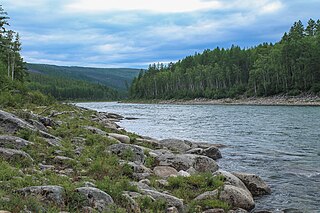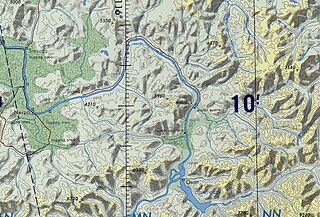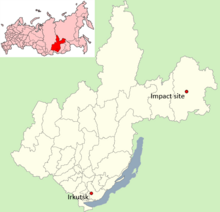
A meteorite is a solid piece of debris from an object, such as a comet, asteroid, or meteoroid, that originates in outer space and survives its passage through the atmosphere to reach the surface of a planet or moon. When the original object enters the atmosphere, various factors such as friction, pressure, and chemical interactions with the atmospheric gases cause it to heat up and radiate energy. It then becomes a meteor and forms a fireball, also known as a shooting star; astronomers call the brightest examples "bolides". Once it settles on the larger body's surface, the meteor becomes a meteorite. Meteorites vary greatly in size. For geologists, a bolide is a meteorite large enough to create an impact crater.
The Tunguska event was an approximately 12-megaton explosion that occurred near the Podkamennaya Tunguska River in Yeniseysk Governorate, Russia, on the morning of June 30, 1908. The explosion over the sparsely populated Eastern Siberian Taiga flattened an estimated 80 million trees over an area of 2,150 km2 (830 sq mi) of forest, and eyewitness reports suggest that at least three people may have died in the event. The explosion is generally attributed to a meteor air burst: the atmospheric explosion of a stony asteroid about 50–60 metres in size. The asteroid approached from the east-southeast, and likely with a relatively high speed of about 27 km/s (60,000 mph). It is classified as an impact event, even though no impact crater has been found; the object is thought to have exploded at an altitude of 5 to 10 kilometres rather than having hit the surface of the Earth.

A meteoroid is a small rocky or metallic body in outer space.

An impact event is a collision between astronomical objects causing measurable effects. Impact events have physical consequences and have been found to regularly occur in planetary systems, though the most frequent involve asteroids, comets or meteoroids and have minimal effect. When large objects impact terrestrial planets such as the Earth, there can be significant physical and biospheric consequences, though atmospheres mitigate many surface impacts through atmospheric entry. Impact craters and structures are dominant landforms on many of the Solar System's solid objects and present the strongest empirical evidence for their frequency and scale.

The early history of Siberia was greatly influenced by the sophisticated nomadic civilizations of the Scythians (Pazyryk) on the west of the Ural Mountains and Xiongnu (Noin-Ula) on the east of the Urals, both flourishing before the Christian era. The steppes of Siberia were occupied by a succession of nomadic peoples, including the Khitan people, various Turkic peoples, and the Mongol Empire. In the Late Middle Ages, Tibetan Buddhism spread into the areas south of Lake Baikal.

A bolide is normally taken to mean an exceptionally bright meteor, but the term is subject to more than one definition, according to context. It may refer to any large crater-forming body, or to one that explodes in the atmosphere. It can be a synonym for a fireball, sometimes specific to those with an apparent magnitude of −14 or brighter.

The Lena is the easternmost of the three great Siberian rivers that flow into the Arctic Ocean. Permafrost underlies most of the catchment, 77% of which is continuous. It is 4,294 km (2,668 mi) long, and has a drainage basin of 2,490,000 km2 (960,000 sq mi). The Lena is the eleventh-longest river in the world, and the longest river entirely within Russia.

The Vitim is a major tributary of the Lena. Its source is east of Lake Baikal, at the confluence of rivers Vitimkan from the west and China from the east. The Vitim flows first south, bends eastwards and then northward in the Vitim Plateau. Then it flows north through the Stanovoy Highlands and the town of Bodaybo. Including river Vitimkan, its western source, it is 1,978 kilometres (1,229 mi) long, and has a drainage basin of 225,000 square kilometres (87,000 sq mi).
Kosmopoisk, also known as Spacesearch, is a group with interests in ufology, cryptozoology, and other mystery investigations. It started in 1980, and expanded in 2001, to an international movement. In 2004, it registered under the name All-Russian Scientific Organization. Many of the activities are in the form of expeditions to sites that are reputed to have extraterrestrial activity or unusual creatures.

Vadim Alexandrovich Chernobrov (Russian: Вади́м Алекса́ндрович Чернобро́в was the founder and leader of the Kosmopoisk organisation. He was a ufology and mystery enthusiast, as well as a meteorite hunter. He conducted experiments which were supposed to involve time travel, starting in 1987.

Irkutsk International Airport is an international airport on the outskirts of Irkutsk, Russia, at a distance of 60 kilometers from Lake Baikal.

Bodaybo is a town and the administrative center of Bodaybinsky District in Irkutsk Oblast, Russia. It is located 1,290 kilometers (800 mi) from Irkutsk, the administrative center of the oblast.
Lake Cheko is a small freshwater lake in Siberia, near the Podkamennaya Tunguska River, in what is now the Evenkiysky District of the Krasnoyarsk Krai.

A meteor air burst is a type of air burst in which a meteor explodes after entering a planetary body's atmosphere. This fate leads them to be called fireballs or bolides, with the brightest air bursts known as superbolides. Such meteoroids were originally asteroids and comets of a few to several tens of meters in diameter. This separates them from the much smaller and far more common "shooting stars", that usually burn up quickly upon atmospheric entry.

The Patomskiy crater or Patom crater, also known as Конус Колпакова, Konus Kolpakova "Kolpakov cone") is a peculiar rock formation located in the Bodaibo District of the Irkutsk region of southeastern Siberia, 360 kilometres (220 mi) from the district center Bodaibo. It is a large mound made of shattered limestone blocks on the slopes of the Patom Highlands in an area of dense taiga. Its base diameter is about 160 metres (520 ft) and its height about 40 metres (130 ft); the cone's crown is ring-shaped, and in its center there is a smaller mound with a height of about 12 metres (39 ft). The volume of the crater is estimated as 230,000–250,000 cubic metres (8,100,000–8,800,000 cu ft), with a weight of about one million tons.

The Chelyabinsk meteor was a superbolide that entered Earth's atmosphere over the southern Ural region in Russia on 15 February 2013 at about 09:20 YEKT. It was caused by an approximately 18 m (59 ft) diameter, 9,100-tonne (10,000-short-ton) near-Earth asteroid that entered the atmosphere at a shallow 18.3 ± 0.4 degree angle with a speed relative to Earth of 19.16 ± 0.15 kilometres per second. The light from the meteor was briefly brighter than the Sun, visible as far as 100 km (60 mi) away. It was observed in a wide area of the region and in neighbouring republics. Some eyewitnesses also reported feeling intense heat from the fireball.
The 1930 Curuçá River event refers to the possible fall of objects on 13 August 1930 over the area of Curuçá River in Brazil. It is based on the account of a single investigator who interviewed witnesses to the purported event and then wrote a letter to the Vatican Observatory.

The Patom Highlands are a mountainous area in Eastern Siberia, Russia. Administratively most of the territory of the uplands is part of Irkutsk Oblast, with a smaller section in northern Transbaikal Krai.

The Mamakan is a river in Irkutsk Oblast, southern East Siberia, Russia. It is a tributary of the Vitim of the Lena basin. The river is 209 kilometres (130 mi) long, and has a drainage basin of 9,460 square kilometres (3,650 sq mi). There are no settlements by the river, only Mamakan near its mouth by the Vitim.

The Delyun-Uran Range is a mountain range in Irkutsk Oblast and Buryatia, Russia, part of the Stanovoy Highlands.
















